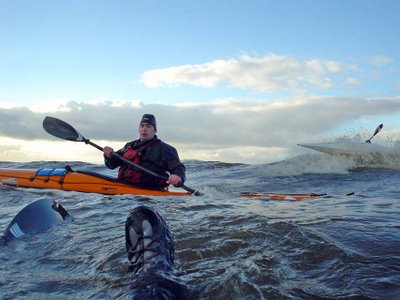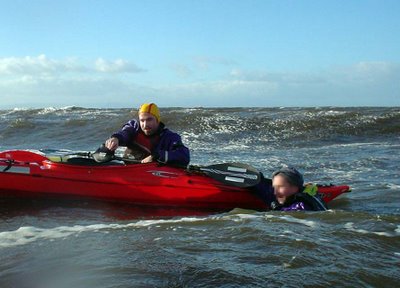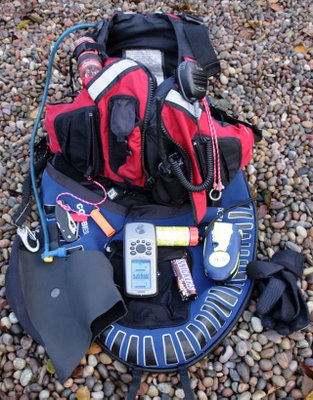
A lot of sea kayakers think they will never fall in because it has not yet happened to them. I suppose there is a sort of logic there, but the sea is an unpredictable mistress and if you go to her often enough...
Here is a shot of me enjoying a fine winter swim with Richard and Cailean coming to my rescue. Being dressed in a drysuit with thick fleece underneath, I was comfortable enough to carry on taking photos.

Cailean calmly directs the rescue of another swimmer.
However, recent reports of a sea kayak rescue on the BBC and Coastguard web sites highlighted another danger apart from cold: the possibility of separation from fellow paddlers and the boat. This particular incident had a happy ending because the paddlers were well dressed and had the means to raise the alarm. The helicopter and lifeboats rescued 4 swimmers who had become separated from the rest of their party in a tidal race.
It was wonderful that this potentially serious event had a happy ending, thanks to the preparation of the kayakers and the skill of the rescuers. It makes you think though. If you got separated from your friends and your boat, would you be able to summon help and survive until it arrived?

If I was in this nightmare scenario, this is the gear I would find in my BA and spray deck pockets. From the top: combined torch and strobe, drinking bladder, external speaker mike for the waterproof VHF in the BA pocket, in the other pocket is my waterproof mobile phone, noseclip, ACR GPS EPIRB satellite distress beacon, neoprene gloves, chocolate bar, day/night flare, GPS unit with Lat/Long set to BIG text, whistle, knife, neoprene hood, cow's tail with snap link. I have been criticised for the cow's tail but the way I see it, it would keep me attached to the boat if I was too cold and tired to hold on. If I was in the water with another paddler, it would keep us together. I would not use it in surf near the shore.
I think I would prefer to have a polythene Nordkapp RM and an EPIRB rather than a carbon?kevlar Nordkapp.
Be safe out there.
Hello Douglas,
ReplyDeleteThank you for such a good post. I found the Icom H-125 external, waterproof speaker in a Barcelona shop. Yet, it is quite expensive and probably it can be found in the UK for a better value. Where did you buy yours?
And the waterproof mobile phone... That it is very interesting. What is the brand?
Hello Wenley,
ReplyDeleteI got the ICOM HM-125 microphone for £70 from www.marine-super-store.com expensive but worth every penny.
My mobile phone is an ancient Nokia 6250. More on that later.
Douglas :o)
Seems like a lot of gear to lug around... I'd wonder if I would still float! There is always the trade-off between what to bring to save oneself and being seen in a rescue situation. Make one wonder.
ReplyDeleteHello Michael,
ReplyDeletethat is a very good point and sometimes in the summer I will only take a BA. But in the winter off the West Coast of Scotland, when the weather is unpredictable, the tides are strong and there are no prawn boats about...
The successful rescue referred to in the post involved a full scale search with a helicopter and 4 lifeboats. Fortunately the alarm was raised in the morning and the search took place in daylight. What if the capsizes had happened at 4 pm as it was getting dark?
Even over the last 4 years I have noticed an increase in numbers sea kayaking in winter. With increased numbers comes the chance of increased incidents.
Douglas
I enjoy your posts on kit Douglas, as I rarely believe everthing I read in the mags, which I even more rarely read. Although kit has much improved in recent years, I haven't found something for me that gives adequate thermal protection to the head. When using an Aquatherm cap I couldn't feel any thermal benefit, although I'm sure it must give some protection. No boubt using with a helmet would give some improvement. I'd really like to continue paddling through the winter, but until I find something I've got complete confidence with, the thought of a complete head immersion is enough to put me off. I don't know how WW paddlers cope - I must be a complete whimp.
ReplyDeleteGrazie, I have tried both the Kogg nog and Reed chillcheater skull cap. I found neither to be very good at keeping me warm in winter.
ReplyDeleteMostly I wear a pile and goretex Lowe Alpine mountain cap. If any wet work is likey to be involved I use my Sola 2.5mmm neoprene (with titanium) windsurfing balaclava. It is very stretchy and you can pull it right over your head and it makes a nice neckwarmer for a dry suit. Then when things get rough, pull it back up again.
Douglas :o)
Yes, I had a Lowe Alpine mountain cap which I used for winter walking, but I think I've lost it. In fact I mostly found it too warm. I'll look out for the Sola balaclava. Don't you get the Mick taken for Hoff tendencies?
ReplyDeleteGrazie, I have NEVER been mistaken for the Hoff!
ReplyDeleteDouglas :o)
Douglas,
ReplyDeleteWhat are the advantages of having the VHF external waterproof speaker - don't you still need a hand for channel selection and PTT?
Hello Gordon, there is a very large PTT (Press to Talk) on the external mic/speaker. If we are in a party in good conditions we just leave our radios on one of the intership channels (up here on the West Coast of Scotland, they are all pretty quiet). This makes it very easy to communicate with the rest of the group eg "come round this point quietly, there are two otters." We have used radios much more since we got the external mic/speakers.
ReplyDeleteIf it was really foul or in seriously deteriorating conditions we might switch over to channel 16. If ever a Mayday call was necessary, it could then be made by pressing the button.
Hope that helps :o)